| Revision as of 04:50, 26 December 2020 editJeanClaudeN1 (talk | contribs)Extended confirmed users2,140 editsNo edit summary← Previous edit | Revision as of 05:01, 26 December 2020 edit undoJeanClaudeN1 (talk | contribs)Extended confirmed users2,140 editsNo edit summaryNext edit → | ||
| Line 27: | Line 27: | ||
| | established_date = 1 April 2001 | | established_date = 1 April 2001 | ||
| | subdivision_type3 = Largest cities | | subdivision_type3 = Largest cities | ||
| | subdivision_name3 = ] |
| subdivision_name3 = ]<br />]<br />]<br />] | ||
| | population_metro = 5,821,523 | | population_metro = 5,821,523 | ||
| | area_metro_km2 = 14800 | | area_metro_km2 = 14800 | ||
| Line 62: | Line 62: | ||
| }} | }} | ||
| The '''Rhine-Main Metropolitan Region''', often simply referred to as '''Frankfurt Rhine-Main''', '''Frankfurt Rhine-Main area''' or '''Rhine-Main area''' (German: ''Frankfurt/Rhein-Main'', abbreviated '''FRM''') is the second-largest ] (after ]), with a total population exceeding 5.8 million. The metropolitan region is located in the central-western part of Germany, and stretches over parts of three ]: ], ] and ]. The largest cities in the region are ], ], ], ], ] and ]. | The '''Rhine-Main Metropolitan Region''', often simply referred to as '''Frankfurt Rhine-Main''', '''Frankfurt Rhine-Main area''' or '''Rhine-Main area''' (German: ''Frankfurt/Rhein-Main'', abbreviated '''FRM''') is the second-largest ] (after ]), with a total population exceeding 5.8 million. The metropolitan region is located in the central-western part of Germany, and stretches over parts of three ]: ], ] and ]. The largest cities in the region are ], ], ], ], ], ], ] and ]. | ||
| The polycentric region is named after its core city, Frankfurt |
The polycentric region is named after its core city, Frankfurt, and the two rivers ] and ]. The Frankfurt Rhine-Main area is officially designated as a European Metropolitan region by the German ] and covers an area of roughly {{convert|13000|km2|sqmi|sp=us}}. | ||
| == Subdivisions == | == Subdivisions == | ||
Revision as of 05:01, 26 December 2020
Place in Germany| Rhine-Main Metropolitan Region | |
|---|---|
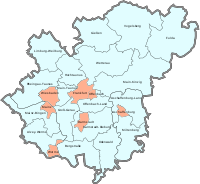 Map of the Rhine-Main metropolitan region Map of the Rhine-Main metropolitan region | |
| Country | |
| States | |
| Largest cities | Frankfurt am Main Wiesbaden Mainz Darmstadt |
| Government | |
| • Type | Frankfurt/Rhine-Main Conurbation Planning Association |
| • Verbandsdirektor | Thomas Horn (CDU) |
| Area | |
| • Metro | 14,800 km (5,700 sq mi) |
| Population | |
| • Metro | 5,821,523 |
| • Metro density | 391.89/km (1,015.0/sq mi) |
| Time zone | UTC+1 (CET) |
| GMP | 2017 |
| Nominal | €268 billion |
| Website | Planungsverband.de |
The Rhine-Main Metropolitan Region, often simply referred to as Frankfurt Rhine-Main, Frankfurt Rhine-Main area or Rhine-Main area (German: Frankfurt/Rhein-Main, abbreviated FRM) is the second-largest metropolitan region in Germany (after Rhine-Ruhr), with a total population exceeding 5.8 million. The metropolitan region is located in the central-western part of Germany, and stretches over parts of three German states: Hesse, Rhineland-Palatinate and Bavaria. The largest cities in the region are Frankfurt am Main, Wiesbaden, Mainz, Darmstadt, Offenbach, Worms, Hanau and Aschaffenburg.
The polycentric region is named after its core city, Frankfurt, and the two rivers Rhine and Main. The Frankfurt Rhine-Main area is officially designated as a European Metropolitan region by the German Federal Ministry of Transport, Building and Urban Affairs and covers an area of roughly 13,000 square kilometers (5,000 sq mi).
Subdivisions
Rhine-Main is a polycentric metropolitan region, but the economic size and political weight of the city of Frankfurt sets it into a very monocentric relation with her commuter belt. Since the early 1970s the Frankfurt am Main metropolitan area (German: Ballungsraum Frankfurt/Rhein-Main) is defined as an area encompassing the cities of Frankfurt and Offenbach and their directly neighboring districts.
The Regierungsbezirk Darmstadt of the state of Hesse could be seen as the next administrative division, for it lies entirely within the metropolitan region and further includes the cities of Darmstadt and Wiesbaden and a number of larger districts. Only on a level further, the metropolitan region also includes the cities and districts of Mainz and Aschaffenburg in the two adjoining federal states of Rhineland-Palatinate and Bavaria.
Metropolitan region and larger urban zones
Eurostat's 'Urban Audit' splits the Frankfurt Rhine-Main region into four Larger Urban Zones (LUZ). These zones do exclude a number of districts in the metropolitan area.
| Hierarchy of planning bodies | Major cities | Area | Population | Refs |
|---|---|---|---|---|
| Frankfurt am Main | 248 km² | 750,000 | — | |
| Offenbach am Main | 45 km² | 118,245 | — | |
|
4,305 km² | 2,517,561 | ||
| Wiesbaden | 204 km² | 275,489 | — | |
| Darmstadt | 122 km² | 142,191 | — | |
|
7,445 km² | 3,778,689 | — | |
| Mainz | 98 km² | 196,784 | — | |
| Aschaffenburg | 63 km² | 68,646' | — | |
|
14,800 km² | 5,821,523 | — | |
| Larger Urban Zone | Major cities | Area | Population | Refs |
|
4,305 km² | 2,517,561 | ||
| Frankfurt am Main | 248 km² | 670,095 | ||
| Offenbach am Main | 45 km² | 118,245 | ||
|
1,015 km² | 459,633 | ||
| Wiesbaden | 204 km² | 275,489 | ||
|
781 km² | 430,993 | ||
| Darmstadt | 122 km² | 142,191 | ||
|
704 km² | 386,173 | ||
| Mainz | 98 km² | 196,784 | ||
Cities and districts
| Picture | City or district | Area | Population |
|---|---|---|---|

|
Frankfurt am Main | 248 km² | 750,000 |

|
Offenbach am Main | 45 km² | 118,245 |

|
Landkreis Offenbach | 356 km² | 337,986 |

|
Main-Kinzig-Kreis | 1,397 km² | 411,956 |

|
Wetteraukreis | 122 km² | 142,191 |

|
Hochtaunuskreis | 482 km² | 233,427 |
| — | Main-Taunus-Kreis | 122 km² | 142,191 |

|
Darmstadt | 122 km² | 142,191 |

|
Landkreis Darmstadt-Dieburg | 659 km² | 289,102 |

|
Landkreis Groß-Gerau | 453 km² | 253,502 |

|
Wiesbaden | 204 km² | 275,489 |

|
Rheingau-Taunus-Kreis | 98 km² | 196,784 |
| Subtotal | Hesse | 7,445 km² | 3,778,689 |

|
Mainz | 98 km² | 196,784 |
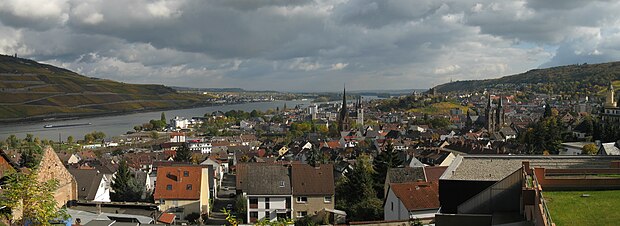
|
Mainz-Bingen | 606 km² | 201,451 |
| — | Worms | 109 km² | 81,784 |
| — | Landkreis Alzey-Worms | 588 km² | 124,758 |
| Subtotal | Rhineland-Palatinate | 1405 km² | 604,777 |
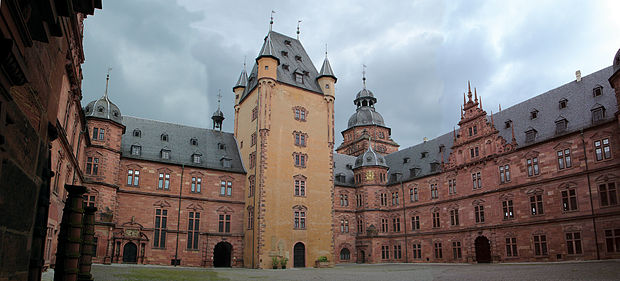
|
Aschaffenburg | 63 km² | 68,646 |
| — | Landkreis Aschaffenburg | 699 km² | 173,946 |

|
Landkreis Miltenberg | 716 km² | 130,009 |
| Subtotal | Bavaria | 1,478 km² | 372,601 |
| Total | Frankfurt Rhine-Main metropolitan region | 14,800 km² | 5,800,000 |
Traffic
The growth of the area is chiefly to be traced to the favorable communications that promoted an early industrialization. Today, however, the importance of industrial concerns has to a great extent been replaced by banking, trade and logistics. Frankfurt lies within the populous Blue Banana region of Europe, which here runs along the Rhine valley, and the city is also a stepping stone from and to various parts of Switzerland and Southern Germany. The Rhine-Ruhr is accessible via a one-hour trip on the Cologne–Frankfurt high-speed rail line, and the air route Frankfurt-Berlin is the busiest in German domestic air travel.
Frankfurt Airport is the busiest airport by passenger traffic in Germany and one of the three busiest airports in Europe. Thereby, along with a strong railway connection, the area also serves as a major transportation hub.
Education
The Frankfurt/Rhine-Main metropolitan region is home to five universities and over 20 partly postgraduate colleges, with a total of over 200,000 students. The region's three public research universities, the
make up the Rhine Main Universities alliance. Private universities in the Frankfurt/Rhine-Main metropolitan region are
Notable colleges and universities of applied sciences (Fachhochschulen) include:
- Darmstadt University of Applied Sciences
- Frankfurt University of Applied Sciences
- RheinMain University of Applied Sciences
- Frankfurt University of Music and Performing Arts
- Städelschule
- University of Applied Sciences, Mainz
- Catholic University of Applied Sciences, Mainz
See also
Gallery
-
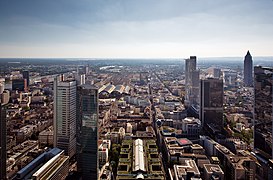 Frankfurt is the most important city of the Rhein-Main area
Frankfurt is the most important city of the Rhein-Main area
-
 Rheingau
Rheingau
-
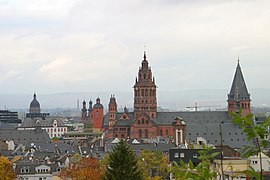 Old town of Mainz
Old town of Mainz
-
 Castle of Johannisburg in Aschaffenburg
Castle of Johannisburg in Aschaffenburg
-
 German House of Goldsmiths in Hanau
German House of Goldsmiths in Hanau
-
 Rhenish Hesse
Rhenish Hesse
-
 Darmstadt Artists' Colony
Darmstadt Artists' Colony
-
 Town Hall of Michelstadt
Town Hall of Michelstadt
References
- Regionalverband FrankfurtRheinMain. "Regionalverband FrankfurtRheinMain /". planungsverband.de.
- https://www.statistik-bw.de/VGRdL/tbls/RV2014/R2B1.zip
- Regionalverband FrankfurtRheinMain. "Regionalverband FrankfurtRheinMain /". planungsverband.de.
- "City Profiles". Archived from the original on 2008-06-26. Retrieved 2009-06-20.
- "Frankfurt a.M. - Städtestatistik im Internet". staedtestatistik.de.
- "Umlichen_Ebenen_des_UrbanAudit" (PDF).
- "City Profiles". Archived from the original on 2008-06-26. Retrieved 2009-06-20.
- "Wiesbaden, LH - Städtestatistik im Internet". staedtestatistik.de.
- "Country Code". Archived from the original on 2012-03-20.
- "Darmstadt - Städtestatistik im Internet". staedtestatistik.de.
- "Country Code". Archived from the original on 2008-06-26. Retrieved 2009-06-20.
- "Mainz, LH - Städtestatistik im Internet". staedtestatistik.de.
External links
- Planungsverband Ballungsraum Frankfurt/Rhein-Main Frankfurt/Rhine-Main Conurbation Planning Association
- Region Frankfurt RheinMain online - Gateway to Europe
- Frankfurt International Airport
- Rhein-Main Metropolitan Transit
- Frankfurt Economic Support
- Frankfurt/Rhein-Main 2020 – the European metropolitan region
- One region - Boundless possibilities
| Metropolitan regions in Germany | ||
|---|---|---|
| Cities in Germany by population | |
|---|---|
| 1,000,000+ | |
| 500,000–999,999 | |
| 200,000–499,999 | |
| 100,000–199,999 |
|
50°06′N 8°42′E / 50.1°N 8.7°E / 50.1; 8.7
Categories: